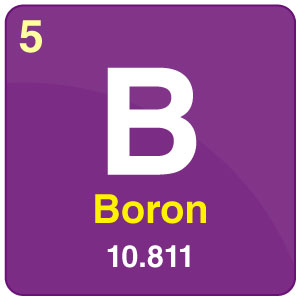Boron

| Symbol | B |
| Atomic Number | 5 |
| Atomic Mass | 10.811 amu |
| Discovered by | Joseph Louis Gay-Lussac in 1808 |

Chemical Properties of Boron
| Group | 13 (Boron Group) | Melting point | 2349K |
| Period | 2 | Boiling point | 4200K |
| Block | p-block | Density (g cm−3) | 2.08 (when liquid) |
| Atomic number | 5 | Electron configuration | [He]2s22p1 |
| State at 20°C | Solid |
What is Boron?
- Boron is a chemical element with atomic number five and it is a trace element that is found in the earth’s crust and solar system. Boron is a metalloid.
Uses of Boron
- Sodium tetraborate decahydrate or borax is the most important compound of boron, which is used to insulate fiber glass and sodium perborate bleach.
- Boric acid is one of the important compounds in textile products. Boron compounds are also used in organic synthesis, in a particular type of glass manufacture and as a wood preservative.
- Borax was earlier used to make perborate, which is the bleaching agent widely used in some detergents.
- Boron compounds are also found in homes in the form of food preservatives, especially for fish and margarine.
Properties of Boron
- It’s a poor conductor of electricity and can also be found in ceramics, flare guns, and fiber glasses.
- Boron has several forms such as amorphous boron which is a dark powder and it is non-reactive to oxygen, water, alkalis, and acids are the most common. It forms borides when it reacts with metals.
Certain Facts About Boron
- Boron is present over a hundred minerals on Earth. But it is extremely difficult to produce, even in laboratory conditions.
- Boromycin is a boron-based natural antibiotic. It is a derivative of Streptomyces.

Comments